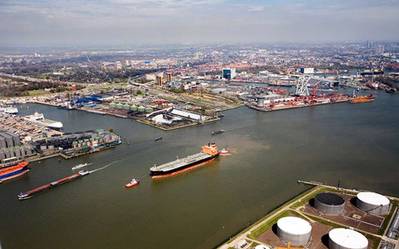The Port of Rotterdam handled roughly the same volume of cargo in the first quarter of 2016 as in the same period last year, as an increase in the volume of, mainly, crude oil and oil products put through the port was offset by a more or less equivalent decrease in the volume of dry bulk and containers. The total volume of cargo handled in the port increased by 0.2 percent, to 116.9 million metric tons.
“The port’s throughput grew by 4.9 percent in 2015. Our ambition is to match this high throughput volume in the present year,” said Port of Rotterdam Authority CEO, Allard Castelein. “So far we are on course – but we still have three quarters to go.”
In the liquid bulk market segment, the port handled higher volumes of crude oil (+2 percent; 26 million metric tons), mineral oil products (+7 percent; 24.4 million metric tons) and other liquid bulk (+2.1 percent; 7.8 million metric tons). The low oil prices have resulted in substantial margins for the refineries, increased refining activity and strong trade in oil products. In the other liquid bulk segment, Rotterdam saw a slight decrease in the volume of MTBE (a petrol additive) put through the port, and a modest increase in biodiesel volumes. The only segment that saw considerable decline in its throughput volumes was LNG (-72.6 percent; 0.1 million metric tons). A substantially lower volume of LNG was re-exported to non-EU destinations in the first quarter. LNG throughput volumes are expected to recover over the remainder of 2016. All in all, the throughput of liquid bulk rose by 3.3 percent to 58.4 million metric tons.
The key cargo types within the dry bulk category are iron ore and scrap metal and coal. There was a sizeable decrease in the throughput of iron ore and scrap metal (-6.1 percent; 7.8 million metric tons). The main cause of this decline was the large quantity of Chinese steel dumped on the European market. The volume of coal put through Rotterdam increased slightly (+2.9 percent; 7.9 million metric tons). The key contributor to this growth was ThyssenKrupp’s decision to concentrate its supply of cokes via Rotterdam. The decommissioning of the Nijmegen and Geertruidenberg (Amer 8) coal-fired power stations and the extremely mild winter led to a slight reduction in plant coal imports. A decrease in the import of raw materials for the metal industry and the construction sector, combined with a decrease in the export of fly ash, resulted in lower throughput volumes for other dry bulk (-18.6 percent; 2.7 million metric tons). There was a slight increase in the volume of agri-bulk handled in the port (+1.2 percent; 2.5 million metric tons). All in all, the throughput of dry bulk decreased by 4 percent to 21 million metric tons.
The volume of containers handled via the port decreased by 3.1 percent, to 31 million metric tons, and by 3.9 percent to 3 million TEU (standard container capacity unit). The lack of growth in this sector can mainly be attributed to unfavorable economic developments in China, Russia and Brazil. In addition, fewer empty containers were shipped to foreign destinations – particularly to Asia (-14.5 percent) – partly as a result of the slowdown in Chinese exports. At the same time, Rotterdam saw an increase in its trade with the U.S., the U.K., Ireland, Spain and Portugal. And roll-on/roll-off transports to the U.K. are still on the rise (+1.8 percent; 5.4 million metric tons). The volume of other breakbulk handled in the port also grew (+6.7 percent; 1.2 million metric tons), resulting in an increase of 2.7 percent in throughput in the breakbulk market segment (ro/ro and other breakbulk), to a total of 6.6 million metric tons.







